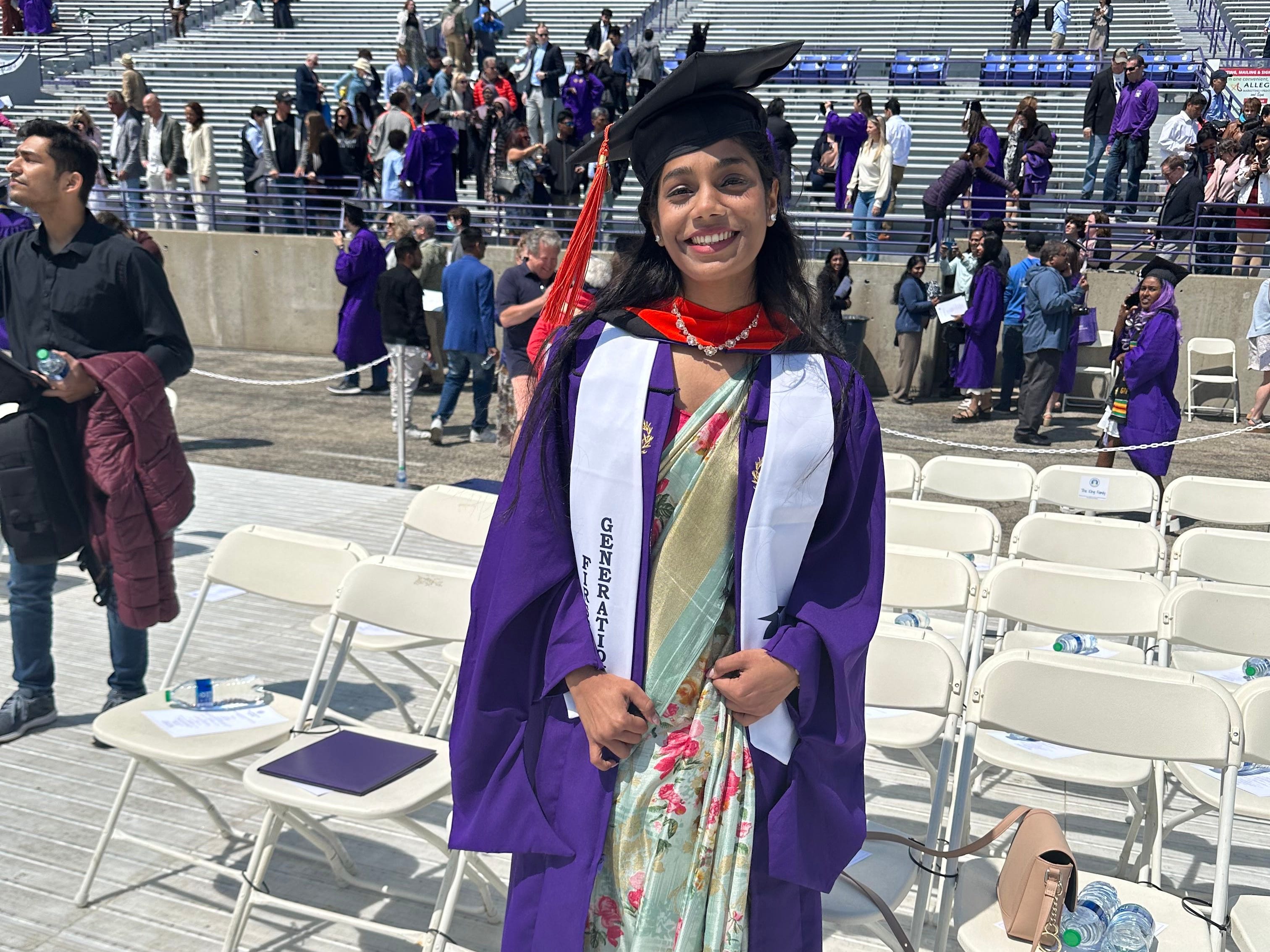
Karishma Mandal
- Karishma Mandal moved from Chicago to San Francisco, hoping to land a Big Tech job.
- She interviewed at Uber, Meta, and Amazon — and landed a product manager role at Salesforce.
- Mandal shared her top job search strategies for making connections and landing interviews.
Karishma Mandal wanted to be at the center of the tech world — working in AI at a big-name company in San Francisco. So she moved across the country — and tapped every job search strategy in her toolbox, hoping to land an offer.
Mandal’s career journey — which would include interviews at Uber, Meta, Amazon, and Salesforce — began when she moved to the US from India in 2021 to pursue a master’s in engineering management at Northwestern University. After graduating in January 2023, she began working full-time in March of that year as a product manager at a consulting firm in Chicago — before leaving for a senior product manager role at a healthcare company that November.
The position was remote, with team members spread across the country. In her first few months on the job, Mandal said she missed working with people in person — and the time zone differences made it even harder to connect with colleagues.
At the same time, she kept hearing about tech meetups and professional events happening regularly in San Francisco — opportunities she said were harder to find in Chicago. There was also the unavoidable buzz around generative AI, the future of which seemed increasingly centered in the Bay Area.
San Francisco, she realized, was where she needed to be. So she started planning a move, with the goal of eventually landing an AI-focused role at a large tech company.
“I felt like, as a tech person, I had to be in San Francisco,” said the 29-year-old.
But one big hurdle stood in the way of her plan: the tough tech job market.
Mandal is among the many tech professionals who’ve struggled to find work or to change jobs in recent years. While layoffs across the US economy remain low by historical standards, tech workers have been hit particularly hard. Since the start of 2025, global tech companies — including Microsoft, Google, and Amazon — have collectively laid off more than 80,000 employees, according to Layoffs.fyi. These cuts have coincided with a broader slowdown in white-collar hiring. Amid tariff uncertainty and the early effects of AI adoption, US companies are now hiring at nearly the slowest pace since 2014.
Still, some job seekers have found ways to break through. Mandal shared how she landed interviews at several tech giants — and ultimately secured a role at Salesforce.
We want to hear from job seekers and people who recently landed a job. If you’re open to sharing your story, please fill out one of the linked Google Forms above. You can also find more of our job market coverage below:
- A former Microsoft worker has been job-hunting for 9 months. He says it feels like companies are ‘looking for Superman.’
- I applied to over 500 jobs but couldn’t find a full-time job for 8 months. This networking strategy helped me finally get one.
- The milestone that divides Gen Z’s career fortunes
- Job searching in 2025? It’s a mess no matter how old you are.
Apply early, directly, and ideally with a referral
In May 2024, Mandal moved to San Francisco while continuing to work remotely for the healthcare company. She said she didn’t start job hunting right away, in part because the move was overwhelming. There were boxes to unpack, and she didn’t have any friends or family in the area. Instead, she focused on settling in and building her social and professional network from scratch.
“When I came to San Francisco, I really had no one,” she said.
When Mandal began her job search in September 2024, she sensed the tech hiring landscape wasn’t in her favor. To gain traction, she believed she needed to connect directly with hiring managers and recruiters.
Rather than simply applying to job listings, she looked for people who were actively posting about open product manager roles on LinkedIn. One trick she used was searching “product manager + hiring” — a combination that filtered for posts containing both terms. Then she’d apply LinkedIn’s “past 24 hours” filter to surface the newest listings.
To take things a step further, she’d tweak the URL manually — changing the number of seconds from 86,400 (24 hours) to 3,600 (1 hour) — to see posts from the past hour.
Once she found a post of interest, Mandal said she’d message the recruiter or hiring manager — explaining why she was interested in the role and why she thought she’d be a good fit.
In addition to filtering LinkedIn posts, Mandal applied the same logic to the platform’s job listings tab — using filters to uncover the newest openings. Based on conversations with recruiters and her network, she said she thinks it’s crucial to be among the first 20 or 30 applicants for a role. Many recruiters, she said, are far more likely to closely review the 20th application than the 200th or the 2,000th. Career experts previously told Business Insider that being among the first applicants could give candidates an edge.

Karishma Mandal
Mandal was also strategic about how she submitted applications. She said an HR professional at one company told her they prioritized applications submitted directly through their website over those sourced via LinkedIn — even if the candidate was redirected there from a LinkedIn post. Mandal figured following that advice couldn’t hurt her chances.
To get an extra edge, Mandal said she used the referral platform Refer.me to secure referrals for roles at McKinsey and Best Buy. A free account allows users to send one referral request a week to employees at a wide range of companies.
“You have to be early, you have to be through the direct website, and you have to get a referral if you can,” Mandal said of her job search strategies.
Interviewing at Amazon, Uber, Meta, and Salesforce
Over time, Mandal’s job search strategies began to pay off. She said reaching out to an Amazon recruiter and an Uber hiring manager on LinkedIn — after seeing their posts about open roles — helped her secure interviews at both companies. A separate referral from a Meta employee — sourced outside Refer.me — led to another interview. Business Insider has verified her interview offers by reviewing emails she received from the respective companies.
Mandal said her Uber interview included a case study involving AI tools built around user communication data, while Meta’s featured questions about measuring the performance of AI features on Instagram. The Amazon interview, she said, focused more on the company’s leadership principles.
These interviews didn’t ultimately lead to offers. But in late 2024, Mandal messaged a Salesforce recruiter on LinkedIn who had posted about an AI-related product manager role — and eventually heard back to schedule an interview.
Over the next several weeks, Mandal said she went through a seven-round interview process that included a design exercise where she was asked to create an AI-powered lawn mower; conversations with the engineering, product, and AI teams; and a final interview with a senior leader.
“They’re not limited to behavioral questions,” she said of Salesforce interviews. “Most hiring managers want to see real expertise.”
Mandal said she received an offer from Salesforce around the end of the year, which included a six-figure salary about 40% higher than what she earned in her previous role. She started full-time in January.
While San Francisco’s high cost of living has been frustrating at times, she said the career benefits have made relocating from Chicago worthwhile.
“If you are trying to make a big career move in tech, I’d recommend living in San Francisco and seeing how you can leverage your network,” she said.
Read the original article on Business Insider
The post A Northwestern grad shares how she landed job interviews at Uber, Meta, and Amazon — and a tech role at Salesforce appeared first on Business Insider.




